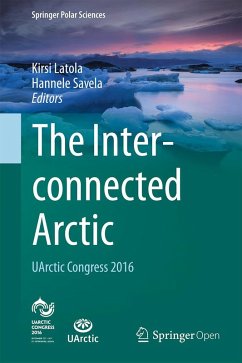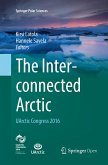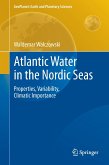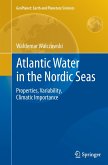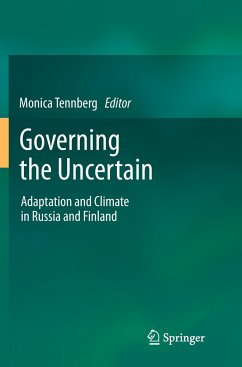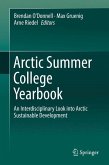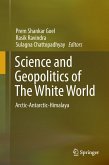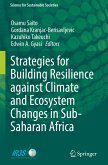The Interconnected Arctic ¿ UArctic Congress 2016
Herausgegeben:Latola, Kirsi; Savela, Hannele
The Interconnected Arctic ¿ UArctic Congress 2016
Herausgegeben:Latola, Kirsi; Savela, Hannele
- Gebundenes Buch
- Merkliste
- Auf die Merkliste
- Bewerten Bewerten
- Teilen
- Produkt teilen
- Produkterinnerung
- Produkterinnerung
This open access book presents the most current research results and knowledge from five multidisciplinary themes: Vulnerability of Arctic Environments, Vulnerability of Arctic Societies, Local and Traditional Knowledge, Building Long-term Human Capacity, New Markets for the Arctic, including tourism and safety. The themes are those discussed at the first ever UArctic Congress Science Section, St. Petersburg, Russia, September 2016. The book looks at the Arctic from a holistic perspective; how the environment (both marine and terrestrial) and communities can adapt and manage the changes due to…mehr
Andere Kunden interessierten sich auch für
![The Interconnected Arctic ¿ UArctic Congress 2016 The Interconnected Arctic ¿ UArctic Congress 2016]() The Interconnected Arctic ¿ UArctic Congress 201637,99 €
The Interconnected Arctic ¿ UArctic Congress 201637,99 €![Atlantic Water in the Nordic Seas Atlantic Water in the Nordic Seas]() Waldemar WalczowskiAtlantic Water in the Nordic Seas74,99 €
Waldemar WalczowskiAtlantic Water in the Nordic Seas74,99 €![Atlantic Water in the Nordic Seas Atlantic Water in the Nordic Seas]() Waldemar WalczowskiAtlantic Water in the Nordic Seas74,99 €
Waldemar WalczowskiAtlantic Water in the Nordic Seas74,99 €![Governing the Uncertain Governing the Uncertain]() Governing the Uncertain74,99 €
Governing the Uncertain74,99 €![Arctic Summer College Yearbook Arctic Summer College Yearbook]() Arctic Summer College Yearbook37,99 €
Arctic Summer College Yearbook37,99 €![Science and Geopolitics of The White World Science and Geopolitics of The White World]() Science and Geopolitics of The White World110,99 €
Science and Geopolitics of The White World110,99 €![Strategies for Building Resilience against Climate and Ecosystem Changes in Sub-Saharan Africa Strategies for Building Resilience against Climate and Ecosystem Changes in Sub-Saharan Africa]() Strategies for Building Resilience against Climate and Ecosystem Changes in Sub-Saharan Africa74,99 €
Strategies for Building Resilience against Climate and Ecosystem Changes in Sub-Saharan Africa74,99 €-
-
-
This open access book presents the most current research results and knowledge from five multidisciplinary themes: Vulnerability of Arctic Environments, Vulnerability of Arctic Societies, Local and Traditional Knowledge, Building Long-term Human Capacity, New Markets for the Arctic, including tourism and safety. The themes are those discussed at the first ever UArctic Congress Science Section, St. Petersburg, Russia, September 2016. The book looks at the Arctic from a holistic perspective; how the environment (both marine and terrestrial) and communities can adapt and manage the changes due to climate change. The chapters provide examples of the state-of-the-art research, bringing together both scientific and local knowledge to form a comprehensive and cohesive volume.
Except where otherwise noted, this book is licensed under a Creative Commons Attribution 4.0 International License. To view a copy of this license, visit http://creativecommons.org/licenses/by/4.0/.
Except where otherwise noted, this book is licensed under a Creative Commons Attribution 4.0 International License. To view a copy of this license, visit http://creativecommons.org/licenses/by/4.0/.
Produktdetails
- Produktdetails
- Springer Polar Sciences
- Verlag: Springer / Springer International Publishing / Springer, Berlin / UArctic
- Artikelnr. des Verlages: 978-3-319-57531-5
- 1st ed. 2017
- Seitenzahl: 328
- Erscheinungstermin: 29. Juni 2017
- Englisch
- Abmessung: 241mm x 160mm x 24mm
- Gewicht: 654g
- ISBN-13: 9783319575315
- ISBN-10: 3319575317
- Artikelnr.: 47848258
- Springer Polar Sciences
- Verlag: Springer / Springer International Publishing / Springer, Berlin / UArctic
- Artikelnr. des Verlages: 978-3-319-57531-5
- 1st ed. 2017
- Seitenzahl: 328
- Erscheinungstermin: 29. Juni 2017
- Englisch
- Abmessung: 241mm x 160mm x 24mm
- Gewicht: 654g
- ISBN-13: 9783319575315
- ISBN-10: 3319575317
- Artikelnr.: 47848258
The first ever UArctic Congress science section in St.Petersburg in September 2016 has taken its themes from ICARP III statement and report. The third International Conference on Arctic Research Planning (ICARP III) provided a framework for identifying Arctic science priorities for the next decade; coordinating various Arctic research agendas; informing policy makers, people who live in or near the Arctic and the global community and building constructive relationships between producers and users of knowledge. It was an effort of over 20 Arctic organisations and after the final conference in Toyama 2015 first the statement was given and then in early 2016 the report. The key points given at the statement were used in planning the UArctic congress themes: 1. Vulnerability of Arctic Environments 2.. Vulnerability of Arctic Societies 3. Local and traditional knowledge 4. Building long-term human capacity 5. New markets for the Arctic, including trade, tourism and transportation.
Part I Vulnerability of the Arctic environments. Chapter 1 Mysteries of the geological history of the Cenozoic Arctic Ocean sea ice cover.- Chapter 2 Response of Arctic alpine biota to climate change -evidence from Polar Urals GLORIA summits.- Chapter 3 The features of natural and artificial recovery in quarries of the forest-tundra zone of Western Siberia.- Chapter 4 The concept of hierarchical structure of large marine ecosystems in the zoning of Russian Arctic shelf seas.- Chapter 5 Changing climate and outbreaks of forest pest insects in a cold northern country, Finland.- Chapter 6 Wood-based energy as a strategy for climate change mitigation in the Arctic -Perspectives on assessment of climate impacts and resource efficiency with Life Cycle Assessment.- Chapter 7. Geospatial analysis of persistent organic pollutant deposits in the Arctic ecosystems and environment.- Chapter 8 Hydrological probabilistic model MARCS and its application to simulate the probability density functions of multi-year maximal runoff: the Russian Arctic as a case of study.- Chapter 9 Student contribution: Assessment of Atmospheric Circulation in the Atlantic-Eurasian Region and Arctic Using Climate Indices. The Possible Applications of these Indices in Long-term Weather Forecasts.- Chapter 10 Student contribution: Difficulties of Geological Engineering in Arctic Seas.- Part II Vulnerability of the Arctic societies. Chapter 11 The Health Transition: A challenge to indigenous peoples in the Arctic.- Chapter 12 Uncertainties in Arctic socio-economic scenarios.- Chapter 13 Importance of consideration of climate change at managing fish stocks: A case of northern Russian fisheries.- Chapter 14 Preservation of territories and traditional activities of the northern indigenous peoples in the period of the Arctic industrial development.- Chapter 15 The Arctic journey- design experiments in the north.- Chapter 16 The Bicycle and the Arctic. Resilient and sustainable transport in times of climate change.- Part III Building the long-term human capacity. Chapter 17 Human capital development in the Russian Arctic.- Chapter 18 Impact of wages on employment and migration in the High North of Russia.- chapter 19 Well-being in an Arctic city. Designing a longitudinal study on student relationships and perceived quality of life.- Chapter 20 Researching Links between Teacher Wellbeing and Educational Change: Case Studies from Kazakhstan and Sakha Republic.- chapter 21 Student contribution: Well-being at the Polish polar station, Svalbard: Adaptation to extreme environments.- Part IV Arcitc tourism. Chapter 22 Tourism futures in the Arctic.- chapter 23 Uniqueness as a draw for riding under the midnight sun.- Chapter 24 Arctic tourism: the design approach with referenceto the Russian North.- Part V Arctic safety. Chapter 25 Maritime operations and emergency preparedness in the Arctic -competence standards for search and rescue operations contingencies in polar waters.- Chapter 26 Risk reduction as a result of implementation of the functional based IMO Polar Code in the Arctic cruise industry.- Chapter 27 Safety of industrial development and transportation routes in the Arctic (SITRA) -collaboration project for research and education of future High North experts.- Chapter 28 Safe Snow and Ice Construction to Arctic Conditions.- Chapter 29 The components of psychological safety of oil and gas shift workers in the Arctic.- Part VI Circumpolar, inclusive and reciprocal Arctic. Chapter 30 Where is gender? Cracking the Arctic box and its persistent "gender neutral" research agendas.- Chapter 31 Towards an Arctic awakening: Neocolonialism, sustainable development, emancipatory research, collective action, and Arctic regional policymaking.
Part I Vulnerability of the Arctic environments. Chapter 1 Mysteries of the geological history of the Cenozoic Arctic Ocean sea ice cover.- Chapter 2 Response of Arctic alpine biota to climate change -evidence from Polar Urals GLORIA summits.- Chapter 3 The features of natural and artificial recovery in quarries of the forest-tundra zone of Western Siberia.- Chapter 4 The concept of hierarchical structure of large marine ecosystems in the zoning of Russian Arctic shelf seas.- Chapter 5 Changing climate and outbreaks of forest pest insects in a cold northern country, Finland.- Chapter 6 Wood-based energy as a strategy for climate change mitigation in the Arctic -Perspectives on assessment of climate impacts and resource efficiency with Life Cycle Assessment.- Chapter 7. Geospatial analysis of persistent organic pollutant deposits in the Arctic ecosystems and environment.- Chapter 8 Hydrological probabilistic model MARCS and its application to simulate the probability density functions of multi-year maximal runoff: the Russian Arctic as a case of study.- Chapter 9 Student contribution: Assessment of Atmospheric Circulation in the Atlantic-Eurasian Region and Arctic Using Climate Indices. The Possible Applications of these Indices in Long-term Weather Forecasts.- Chapter 10 Student contribution: Difficulties of Geological Engineering in Arctic Seas.- Part II Vulnerability of the Arctic societies. Chapter 11 The Health Transition: A challenge to indigenous peoples in the Arctic.- Chapter 12 Uncertainties in Arctic socio-economic scenarios.- Chapter 13 Importance of consideration of climate change at managing fish stocks: A case of northern Russian fisheries.- Chapter 14 Preservation of territories and traditional activities of the northern indigenous peoples in the period of the Arctic industrial development.- Chapter 15 The Arctic journey- design experiments in the north.- Chapter 16 The Bicycle and the Arctic. Resilient and sustainable transport in times of climate change.- Part III Building the long-term human capacity. Chapter 17 Human capital development in the Russian Arctic.- Chapter 18 Impact of wages on employment and migration in the High North of Russia.- chapter 19 Well-being in an Arctic city. Designing a longitudinal study on student relationships and perceived quality of life.- Chapter 20 Researching Links between Teacher Wellbeing and Educational Change: Case Studies from Kazakhstan and Sakha Republic.- chapter 21 Student contribution: Well-being at the Polish polar station, Svalbard: Adaptation to extreme environments.- Part IV Arcitc tourism. Chapter 22 Tourism futures in the Arctic.- chapter 23 Uniqueness as a draw for riding under the midnight sun.- Chapter 24 Arctic tourism: the design approach with referenceto the Russian North.- Part V Arctic safety. Chapter 25 Maritime operations and emergency preparedness in the Arctic -competence standards for search and rescue operations contingencies in polar waters.- Chapter 26 Risk reduction as a result of implementation of the functional based IMO Polar Code in the Arctic cruise industry.- Chapter 27 Safety of industrial development and transportation routes in the Arctic (SITRA) -collaboration project for research and education of future High North experts.- Chapter 28 Safe Snow and Ice Construction to Arctic Conditions.- Chapter 29 The components of psychological safety of oil and gas shift workers in the Arctic.- Part VI Circumpolar, inclusive and reciprocal Arctic. Chapter 30 Where is gender? Cracking the Arctic box and its persistent "gender neutral" research agendas.- Chapter 31 Towards an Arctic awakening: Neocolonialism, sustainable development, emancipatory research, collective action, and Arctic regional policymaking.
